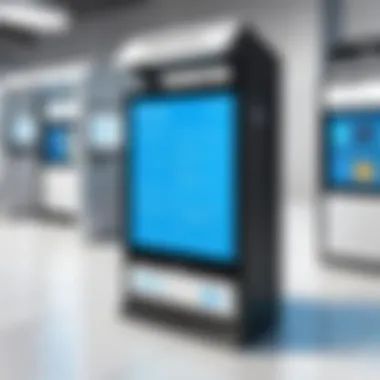Top Android Kiosk Apps for Businesses in 2023


Intro
The surge of technology in business operations has given rise to specialized software solutions, one of which is the Android kiosk app. These applications turn devices into dedicated kiosks for various functions, such as information display, ticketing, or retail services. As organizations increasingly seek ways to enhance customer experiences and streamline operations, the relevance of these apps has never been more pronounced. This article aims to examine the landscape of Android kiosk applications, empowering businesses to navigate the selection process effectively.
Industry Overview
Current Trends in the Industry-specific Software Market
The Android kiosk app market is evolving, influenced by several key trends. Businesses are prioritizing user engagement through interactive interfaces. Moreover, the integration of artificial intelligence and machine learning is enhancing personalization in kiosk services. Remote management is becoming a necessity, allowing businesses to update content and settings seamlessly.
Key Challenges Faced by Buyers in the Industry
While the market buzzes with potential, buyers encounter challenges. Security remains a primary concern. With data breaches becoming rampant, ensuring that kiosk apps protect sensitive information is crucial. Additionally, compatibility issues with existing systems can hinder implementation, leading to increased costs and delays.
Emerging Technologies Impacting the Industry
Emerging technologies, such as augmented reality (AR) and the Internet of Things (IoT), are poised to impact kiosk applications significantly. These technologies enhance user interaction and gather vital data for businesses—that informs decisions.
Top Software Options
Review of Leading Software Providers in the Industry
Several prominent providers dominate the Android kiosk app space. Among them, KioWare stands out for its security features. SureFox is known for its user-friendly interface, while Scalefusion offers comprehensive remote management solutions.
Feature Comparison of Top Software Solutions
When comparing features, consider the following:
- Security Protocols: Encryption and lockdown options.
- Customizability: Ability to customize interfaces for specific use cases.
- Remote Management: Capabilities for managing multiple kiosks remotely.
- Analytics: Built-in tools to analyze user data and interactions.
Pricing Structures of Different Software Options
Pricing can vary significantly. KioWare offers tiered pricing based on feature sets, while SureFox employs a subscription model. Understanding the pricing structure and any potential additional costs for updates or support is essential for budgeting purposes.
Selection Criteria
Important Factors to Consider When Choosing Software
Choosing the right Android kiosk app necessitates careful consideration of factors like:
- Ease of Use: Is the interface intuitive?
- Scalability: Can the solution grow with your business?
- Support and Updates: What kind of technical support does the vendor provide?
Common Mistakes to Avoid During the Selection Process
Avoid the pitfalls of overlooking user feedback and vendor reputation. Additionally, thoroughly evaluate features in relation to your specific application needs. Blindly opting for the cheapest option may not serve long-term goals.
How to Determine the Right Fit for Your Business Needs
To find the right fit, pilot testing different applications is advisable. This allows you to assess usability and determine which app integrates seamlessly with your current systems.
Implementation Strategies
Best Practices for Smooth Implementation of Software Solutions
A project plan with defined goals is vital for successful implementation. Engaging stakeholders throughout the process ensures their input shapes the final outcome.
Integration with Existing Systems and Processes
Technical integration must be seamless. Identify compatibility with existing applications and infrastructure early in the selection process to mitigate issues.
Training and Support Resources for Successful Deployment
Invest in training resources for staff. Comprehensive documentation and ongoing support are critical for navigating the new system effectively.


Future Trends
Predictions for the Future of the Industry-specific Software Landscape
Technological advancements will shape kiosk applications. Increased reliance on cloud solutions and AI-driven insights will redefine how businesses utilize kiosks.
Upcoming Technologies Shaping the Industry
Emerging technologies, such as 5G, will facilitate faster, more reliable connections for kiosks, transforming user experiences and operational efficiency.
Recommendations for Future-Proofing Your Technology Stack
To future-proof your technology, consider modular systems that allow for upgrades. This adaptability ensures longevity as business needs evolve. Regular assessments of new technologies will also keep your solutions relevant.
In a rapidly evolving environment, making informed decisions about kiosk applications is not just strategic but essential for operational success.
Preamble to Android Kiosk Apps
In today's fast-paced business environment, having reliable software solutions for managing customer interactions is essential. Android kiosk apps serve a pivotal role in this realm. They enable businesses to transform Android devices into interactive kiosks, facilitating an array of functions ranging from customer assistance to information dissemination. This article delves into the complexities and functionalities of Android kiosk applications, outlining their significance in enhancing operational efficiency.
Defining Android Kiosk Applications
Android kiosk applications are specialized software designed to restrict user access to certain features and functionalities of Android devices. These apps lock down the device, allowing it to operate in a controlled environment. Typically, they enable specific applications to run in a full-screen mode while blocking access to the device's home screen, notifications, and other non-essential apps. Businesses commonly utilize these applications in venues like retail stores, airports, and hospitals to streamline processes and provide specific services. Understanding these definitions frames the subsequent analysis of their impact on business operations.
The Importance of Kiosk Solutions
The implementation of kiosk solutions can significantly influence a company's customer engagement and operational workflow. Firstly, they enhance user experience by providing customers with easy access to information or services without requiring staff assistance. This can lead to reduced wait times and increased satisfaction. Secondly, kiosk apps can improve security by limiting the functionality of devices. Users are prevented from accessing sensitive data or settings that could potentially compromise the system.
Another critical advantage lies in analytics. Kiosk applications often come with built-in reporting tools that allow businesses to track user behavior and gain insights into customer preferences. This data can guide strategic decisions, making it pivotal for growth. Moreover, these solutions serve as a cost-effective alternative to traditional setups, requiring fewer personnel to manage customer queries.
Key Features of Effective Kiosk Apps
In the ever-evolving landscape of technology, kiosk applications have emerged as vital tools for businesses aiming to streamline user interactions and enhance customer experiences. The features of these apps significantly influence their effectiveness. A deeper understanding of these key capabilities can enable decision-makers and IT professionals to select the most suitable solutions for their needs.
User Interface Design
User interface design (UI) is crucial for any kiosk application. The UI serves as the first point of contact for users. A well-designed interface improves usability and encourages engagement. It should be intuitive, guiding users through tasks without confusion. Important considerations include:
- Simplicity: The layout should be straightforward, with clear icons and labels.
- Accessibility: Design must cater to users of varying abilities, offering features such as voice commands and larger text options.
- Responsiveness: The application should work seamlessly on different screen sizes, adapting effectively to the hardware used.
Good UI design reduces the learning curve and increases the likelihood of user satisfaction.
Security Measures
Security is non-negotiable in kiosk applications. As these systems often handle sensitive data, incorporating robust security measures is critical. Businesses should evaluate the following aspects:
- Data Encryption: Protects user data during transactions and storage by making it unreadable to unauthorized entities.
- Authentication Processes: Implementing multi-factor authentication ensures that only authorized users can access sensitive features.
- Regular Updates: Keeping software updated combats vulnerabilities and fortifies security defenses.
"The integrity of your kiosk application is intrinsically linked to the trust of your users."
Organizations should view security as a continuous process rather than a one-time setup.
Remote Management Capabilities
Remote management is an essential feature for effective kiosk applications. It allows organizations to monitor and control kiosks from afar. This capability becomes especially valuable in scenarios where kiosks are distributed across multiple locations. Key benefits include:
- Instant Troubleshooting: Identifying and resolving issues in real-time minimizes downtime.
- Configuration Management: Changes to settings or updates can be rolled out simultaneously across all kiosks.
- Performance Tracking: Analytics tools can provide insights into user interactions, helping businesses refine their offerings.
Top Android Kiosk Apps of the Year
The selection of the right Android kiosk apps is crucial for any organization seeking to optimize its operational efficiency and customer engagement. These applications play a vital role in controlling and managing users' interaction with devices, allowing businesses to curate a seamless experience. As professionals delve into the available kiosk options, understanding the key players in this market can significantly influence decisions that impact user experiences and operational effectiveness.
By examining the top Android kiosk apps, one identifies various features that distinguish them in functionality, usability, and adaptability. Businesses can harness these insights to make informed choices, ultimately leading to improved productivity and customer satisfaction. This segment not only sheds light on noteworthy applications but also encourages professionals to consider how these tools align with their specific needs.
App A: Features and Use Cases


App A has emerged as a frontrunner in the Android kiosk space due to its robust functionality and intuitive user interface. A distinctive feature of App A is its customizable home screen, allowing businesses to present information in a way that resonates with their target audience. Furthermore, it supports multiple application launching, which enhances user satisfaction by providing seamless transitions between services.
Use cases for App A span various sectors. In retail, it is deployed to guide customers through product selections and promotions. Educational institutions utilize it to display schedules and learning materials, enhancing student engagement. By catering to diverse requirements, App A demonstrates adaptability and an understanding of unique market needs.
App B: Advantages and Disadvantages
App B serves as a commendable choice with a compelling feature set. One of its advantages includes strong security protocols that protect sensitive data and ensure compliance with industry standards. This is critical for sectors like finance and healthcare.
However, it is prudent to consider some disadvantages as well. Users have reported that App B can be somewhat rigid in terms of customization options. While it provides essential functionalities, businesses may find the lack of personalization limits their ability to fully implement brand-specific elements. Weighing these factors allows decision-makers to evaluate alignment with their organization’s objectives.
App C: Customer Feedback and Ratings
App C has garnered significant attention from users, contributing to its strong ratings across various platforms. Customer feedback often highlights its user-friendly interface and comprehensive features, such as remote monitoring capabilities that simplify device management.
Nevertheless, even with its high ratings, some users have raised concerns about the learning curve associated with its advanced features. Detailed reviews can guide potential users by offering insights into real-life experiences and identifying potential challenges to anticipate during implementation.
"While App C excels in functionality, understanding its intricacies can be daunting for first-time users."
In summary, the top Android kiosk apps routinely evolve to meet the dynamic needs of modern businesses. Analyzing their features, advantages, and user feedback provides a solid foundation for making strategic decisions in kiosk adoption.
Comparative Analysis of Kiosk Apps
In the rapidly evolving technology landscape, a comparative analysis of Android kiosk apps serves as a vital tool for decision-makers and IT professionals. Understanding how different applications stack up against one another enables businesses to make informed choices. This analysis encompasses various facets such as cost, features, performance metrics, and user feedback.
A thorough examination allows businesses to weigh the benefits against potential drawbacks. Each application may cater to distinct needs, making it crucial to identify which kiosk solution aligns with your organizational goals. Furthermore, this analysis takes into account market trends and innovations that can impact your overall operation.
Cost vs. Features
Cost is often the primary concern for any organization investing in kiosk applications. However, it is essential to understand that cost should not be the only deciding factor. The range of features offered by various apps can differ significantly. Businesses need to assess whether the price aligns with the functionality provided.
- Budget Considerations: Budget constraints often compel organizations to look for the most economical choices. However, lower cost does not always equate to lower quality. It's vital to evaluate whether cheaper products meet your requirements without sacrificing key features.
- Feature Set Analysis: Different apps may include various functionalities such as customizable user interfaces, integrated analytics, or versatile security measures. List the specific features that are necessary for your operations, which will help in comparing their cost-effectiveness.
- Long-term Value: It's also important to consider the longevity of the app. Sometimes, a more expensive app can deliver greater long-term savings through efficiency and reduced support costs.
Performance Metrics
Performance metrics are crucial in determining the overall effectiveness of any kiosk application. When evaluating kiosk apps, consider the following metrics that can indicate how well the software performs:
- System Responsiveness: Users expect quick interactions. Measure how fast the app responds to commands and the speed of loading times. Delays can lead to frustration and decreased user satisfaction.
- Stability and Reliability: Frequent crashes or errors can undermine the functionality of the kiosk. Review user feedback to identify any recurring issues that may impact performance.
- Scalability: As your business grows, your kiosk needs may change. The ability of an application to scale effectively with increased demand is an important metric to measure.
- User Experience: Ultimately, the efficacy of an app can be measured by end-user satisfaction. Feedback on usability from actual users can provide invaluable insights into performance.
"A detailed comparative analysis of kiosk applications ensures that decision-makers are equipped with the necessary information to select the most suitable tools for their needs."
In summary, the comparative analysis of kiosk applications is essential for making a well-informed decision, especially when considering the diversity of options available in the market. Evaluating cost against features and scrutinizing performance metrics will guide organizations in choosing the most effective kiosk software.
Implementation Strategies for Kiosk Deployment
Implementing kiosk solutions effectively is critical for businesses that aim to leverage technology for improved customer interaction and streamlined operations. The strategies chosen during deployment can significantly influence the ease of use, security, and overall performance of a kiosk system. It's essential to assess both the specific environment where the kiosk will be deployed and the objectives it is meant to fulfill. Thoughtful planning can yield benefits such as reduced downtime, enhanced user interaction, and a more polished service delivery.
Hardware Considerations
Choosing the right hardware is a fundamental aspect of successful kiosk deployment. The hardware selection should align with both intended usage and user experience. Key considerations include:
- User-Friendliness: Kiosks need to be intuitive. This means selecting touch screens and interactive devices that are accessible.
- Durability: Depending on the location, kiosks may be exposed to harsh conditions. Opt for products that are rugged and built to last.
- Connectivity: Ensure the hardware can connect reliably to necessary networks. This may involve Wi-Fi, Ethernet, or mobile data support.
- Compliance: Check for any compliance requirements regarding safety and accessibility, particularly if the kiosk will be used in public spaces.
By prioritizing these elements, you can enhance the kiosk's effectiveness and user satisfaction. A well-chosen kiosk hardware setup will underpin the software's functionality and contribute to achieving operational goals.
Configuration Steps
Once the hardware is selected, the next step involves configuring the system. Proper configuration ensures that the kiosk operates as intended. Consider the following steps:
- Install the Kiosk Application: Start by deploying the chosen Android kiosk app to the device.
- Set Up User Permissions: Define what users can and cannot access on the kiosk. Limiting access helps to maintain security and user focus.
- Customize User Interface: Tailor the graphical interface to suit your brand and make it user-friendly. Features like larger buttons and clear pathways enhance engagement.
- Test Connectivity: Verify that all network connections function correctly before launching the kiosk. Check for issues early in the deployment.
- Conduct Usability Testing: Prior to going live, run tests with real users if possible. This can identify unforeseen usability problems.
- Monitor and Adjust: After deployment, continue to monitor how users interact with the kiosk. Use analytics to inform potential adjustments and enhancements.
"Effective deployment strategies not only facilitate smoother user interaction but also ensure that the technology aligns with business objectives."
By following these implementation strategies, businesses can create a more efficient and user-centered kiosk experience. Beyond just installing a kiosk, it is about creating a tailored solution that meets specific needs while ensuring reliability and security.
Security Best Practices for Kiosk Applications


The deployment of kiosk applications has become increasingly prevalent in various sectors, such as retail, education, and healthcare. As these applications often handle sensitive user data, implementing robust security practices is essential. Effective security measures not only protect the business from potential threats but also enhance customer trust. The cost of a data breach can be significant, impacting both reputation and financial stability. Therefore, understanding and applying security best practices is crucial for any organization utilizing kiosk technologies.
User Data Protection
User data protection is the cornerstone of kiosk application security. Given that many kiosks handle personal information, implementing encryption methods is necessary. Data encryption ensures that sensitive information is transformed into a format that is unreadable without the correct key. This process protects data in transit and at rest.
Here are key elements to consider for effective user data protection:
- Data Encryption: Use strong encryption algorithms like AES (Advanced Encryption Standard) to secure data. This helps in keeping unauthorized access at bay.
- Access Control: Implement strict access controls to define who can view or modify data. Limit access to authorized users to reduce risk.
- User Authentication: Strong authentication methods, such as multi-factor authentication, should be used to verify user identities reliably.
- Regular Audits: Conduct security audits to identify vulnerabilities. Regular checks help maintain data security over time.
Following these practices will not only help protect sensitive information but also strengthen the overall integrity of the kiosk application.
Physical Security Considerations
Physical security measures are equally important in safeguarding kiosk applications. A kiosk is often accessible to the public, making it susceptible to tampering or theft. Addressing these vulnerabilities is essential for operational continuity.
Consider the following physical security strategies:
- Secure Location: Place kiosks in secure areas where access is controlled. Locations with surveillance cameras deter unauthorized activity.
- Tamper-Proof Hardware: Utilize kiosks with tamper-proof casings or alarms that alert if the unit is breached.
- Locking Mechanisms: Use locks for critical areas in the kiosk, particularly those storing hardware components. This prevents unauthorized access.
- Regular Maintenance: Schedule routine inspections to identify potential physical threats. Keeping machinery in good repair reduces the chances of malfunctioning.
Effectively managing physical security is as critical as implementing software security measures. The two should complement each other well.
Future Trends in Kiosk Software
As kiosk applications evolve, understanding their future trends is vital for businesses aiming to stay competitive. Future trends offer insights into potential benefits, adaptability, and the overall strategic fit for organizations. These advancements can enhance user experience, streamline operations, and provide valuable data insights, making kiosk systems more dynamic and effective in meeting business needs.
AI Integration
AI integration is becoming an essential facet of modern kiosk applications. The implementation of artificial intelligence allows for more intuitive user interactions. For example, AI can analyze user behavior to personalize experiences, thus enhancing customer satisfaction.
With AI, kiosks can also leverage natural language processing to facilitate better communication. This capability allows users to interact with kiosks using their own words rather than navigating through complex menus. Additionally, AI can assist in predictive maintenance, identifying issues before they disrupt service, thus minimizing downtime.
"AI is revolutionizing customer engagement by providing tailored solutions that adapt to user behavior and preferences."
Moreover, businesses can use AI for data analytics. Kiosk applications equipped with AI can gather and analyze customer data more efficiently. This information aids decision-makers in strategizing marketing efforts and improving service delivery.
Customization Features
Customization features are increasingly important in kiosk software, allowing businesses to tailor applications to their specific needs. Such features provide flexibility in the user interface and functionality, aligning the kiosk with the brand identity and business objectives.
Customizable templates let organizations configure the look and feel of their kiosks without significant coding knowledge. This promotes quicker deployment and enables businesses to respond to market changes effectively.
Furthermore, customization options often extend to integrations with other systems. For instance, businesses can incorporate their existing software infrastructure with kiosk applications, ensuring a seamless operational flow. This capability is crucial for inventory management, customer relationship management, and other essential functions.
Additionally, incorporating feedback mechanisms within the kiosk software allows businesses to adjust according to user engagement. Simple surveys or rating systems can provide invaluable insights, facilitating ongoing improvements.
In summary, staying ahead in kiosk technology is increasingly linked to embracing trends such as AI integration and robust customization features. These advancements not only enhance user experience but also equip businesses with innovative tools to navigate the complexities of modern market demands.
Ending
In the realm of Android kiosk applications, the conclusion serves as a critical synthesis of the explored material throughout the article. It encapsulates the significant findings, reinforcing the vital aspects of selecting the right kiosk app for specific needs. The discussion on key features, security measures, and the latest trends illustrated how essential it is to make informed decisions in this area.
Recognizing the importance of usability and performance metrics cannot be overstated. With the increasing reliance on digital solutions in business, the choice of kiosk software directly impacts operational efficiency. Therefore, the conclusion is not just a summary; it is a call to action for professionals to prioritize their kiosk app selection process. The longevity and success of kiosk deployments hinge on thoughtful evaluation and well-informed implementation strategies.
By understanding the landscape of available solutions, decision-makers are better positioned to invest in apps that meet both current and future demands.
Summary of Key Insights
Throughout this article, several critical insights emerged regarding Android kiosk applications. Firstly, effective kiosk apps should offer robust security features to protect user data and device integrity.
- User Interface Design is paramount. A clean, intuitive layout enhances user experience and minimizes confusion.
- Remote Management Capabilities allow for seamless oversight of multiple kiosk devices. This feature is essential for businesses operating in various locations.
- Customization Features can elevate user engagement by providing tailored experiences based on specific use cases.
Secondly, a comparative analysis of the top apps revealed discrepancies in cost and performance metrics. Understanding these distinctions aids in making financially sound and efficient choices.
Final Recommendations
In light of the insights presented, several recommendations arise for selecting the best Android kiosk app:
- Prioritize Security: Choose applications that ensure data protection and comply with industry standards.
- Assess User Feedback: Customer reviews provide valuable information about app reliability and shortcomings.
- Consider Scalability: Ensure that the app can adapt as your business grows or changes.
- Conduct Trials: Leverage free trials when available to evaluate usability before commitment.
Adhering to these guidelines can promote more informed decisions and lead to successful kiosk deployments. As the market evolves, staying updated with the latest advancements in Android kiosk technology is crucial for maintaining a competitive edge.



